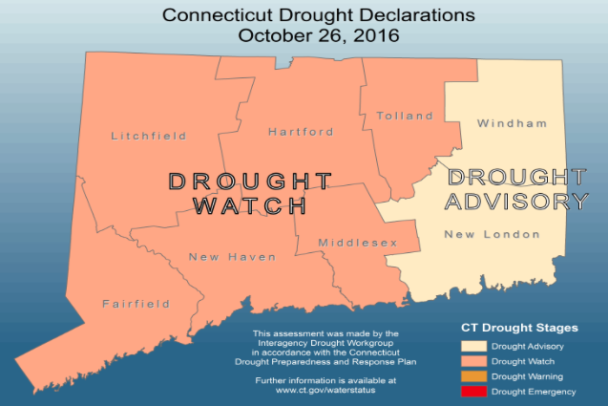The environmental conditions in Connecticut as of June 27 qualified the state for a drought declaration. As a result, local water companies and governments have advised Connecticut residents to limit their outdoor water use in contribution to the water conservation effort.
The Connecticut Water Status Site issued a Press Release June 27 in which the Interagency Drought Advisory Workgroup, which is responsible for ensuring stability in Connecticut’s water supplies, determined that the current conditions fulfilled five of seven drought benchmarks. As a result, the state entered the Drought Advisory stage. The seven benchmarks consist of precipitation, groundwater, streamflow, the Palmer Drought Index, fire danger, reservoir levels, and the Crop Moisture Index. As of June 27, the drought conditions did not fulfill the latter two benchmarks.
The Connecticut Drought Response and Preparedness Plan classifies a Drought Advisory as fulfilling the first of four stages of drought. State and federal agencies monitor the status of the seven aforementioned benchmarks in order to determine if a Drought Advisory is necessary, according to the September 14 Press Release.
The State of Connecticut issued Drought Advisories in 2002, 2007 and 2010. Since the establishment of the Interagency Drought Advisory Workgroup, Connecticut has never experienced conditions beyond the Drought Advisory stage, according to the September 14 Press Release.
Due to worsening drought conditions in Connecticut as of September 14, the Interagency Drought Advisory Workgroup decided to keep the Drought Advisory in effect and began advising individuals and businesses to conserve water.

“This summer has been one of the hottest and driest on record in Connecticut, with only 75 percent of normal precipitation during the past three months. This follows a dry spring and a winter with little snowpack, which led to the issuance of a Drought Advisory in June,” Office of Policy and Management spokesperson Mr. Chris McClure said, according to the September 14 Press Release.
With a few exceptions, the water levels in the state’s largest reservoirs and water systems were stable as of September 14. Still, many water companies put voluntary or mandatory water conservation regulations in place while monitoring the conditions.
“While residents should not be alarmed, they should be mindful of their water consumption and take sensible steps to stretch our water supplies and reduce impacts on other water uses and on the environment,” Mr. McClure said, according to the September 14 Press Release.
High water temperatures, prior to the issue of the September 14 Press Release, led the Department of Energy and Environmental Protection to temporarily close sections of the Farmington River for fishing due to decreased water flow. A significant portion of the state was also in agricultural drought at this time.
The drought conditions are not confined to Connecticut, however, as areas of Rhode Island and Massachusetts are experiencing more severe impacts from the drought.
In the third Press Release on the drought, issued October 28, Connecticut Governor Mr. Dannel Malloy requested residents to voluntarily reduce water use due to the first ever Drought Watch issued in the state.
In particular, local governments and water companies encouraged Connecticut residents to save water by setting a voluntary water use reduction goal of ten or 15 percent depending on the severity of drought conditions in a given area. Litchfield, Tolland, Hartford, Middlesex, New London, and Fairfield Counties are currently under Drought Watch, meaning individuals should cut back outdoor water use by 15 percent, according to ct.gov. New London and Windham Counties remain under Drought Advisory, meaning local governments advise residents to cut back by ten percent.
Connecticut authorities instructed individuals to limit activities, such as watering lawns, washing cars, or filling swimming pools, as well as adhere to the requests and recommendations of local water utility companies according to ct.gov.
The Connecticut drought is ranked a -3.0 to -4.0 or less on the Palmer Drought Severity Index, which indicates severe or extreme levels of dryness. Precipitation levels in Connecticut have been below 65 percent of normal levels for three cumulative months and stream flow has been below normal for four out of the five past months, according to ct.gov.
Thirty four public water systems that utilize surface water supplies provide the data used to monitor reservoir levels as a component of the Drinking Water benchmark. When drought analysts compared the current reservoir capacity levels to historical records, the numbers were 78.5 percent of normal capacity, according to ct.gov.
The Sacred Heart Greenwich Advanced Placement (AP) Environmental Science class attended a field trip at the Greenwich Audubon, where they witnessed firsthand the negative impact of the drought on local bodies of water. Specifically, they were unable to take samples from a stream on the grounds because it had dried up from the drought.
“We hear about the drought and how we have to conserve water, but when the AP Environmental class went to the Audubon and saw the extremely low water levels, it dawned on me just how bad the conditions are,” senior and AP Environmental Science student Maddie McLane said.
Persistent drought in Connecticut is rare as water resources are generally abundant. However, the infrequencies in recent weather patterns have caused low precipitation levels, leading several counties in Connecticut to enter a Drought Watch. Consequently, authorities are advising residents to be cognizant of their water use until conditions improve.
– Jade Cohen, Content Editor
Categories:
Conserving water to end the drought
November 21, 2016
0



Ms. Stewart • Nov 21, 2016 at 4:05 pm
Very well written and researched, Jade. A great tie-in to tomorrow’s Water Conservation Day.